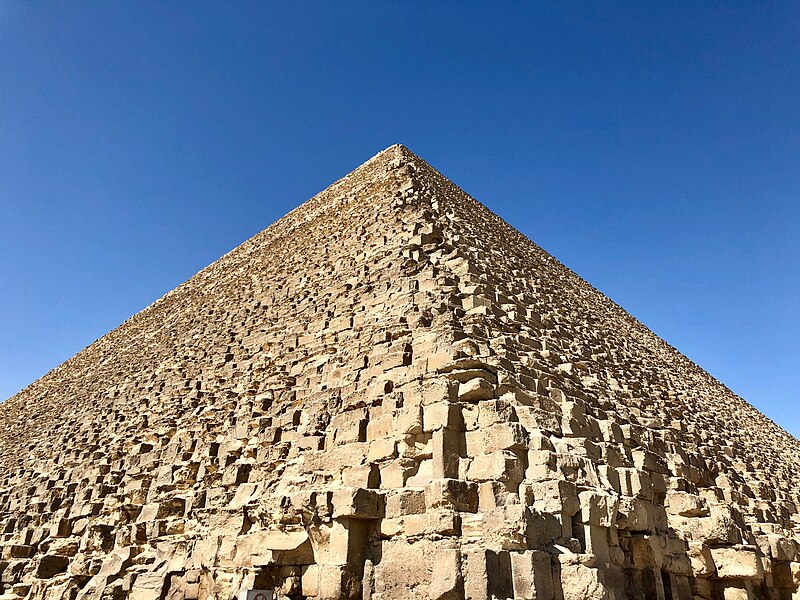File:Great Pyramid (Pyramid of Cheops Khufu), Giza, GG, EGY (40936203693).jpg

Original file (4,032 × 3,024 pixels, file size: 4.52 MB, MIME type: image/jpeg)
Captions
Captions
Summary
[edit]| DescriptionGreat Pyramid (Pyramid of Cheops Khufu), Giza, GG, EGY (40936203693).jpg | These are the famous Pyramids at Giza, located outside the former Ancient Egyptian cities of Memphis and Heliopolis, located south and north of modern-day Cairo, respectively. The earliest pyramids were located at Saqqara, to the south, which included the stepped pyramid, the bent pyramid, and the red pyramid, which were the earliest attempts at pyramids by the Ancient Egyptian Old Kingdom during the 2600s BC. The pyramids at Giza were constructed starting around 2580 BC with the Pyramid of Cheops (Khufu), the tallest of the pyramids, also known as the Great Pyramid. The second tallest is the Pyramid of Khafre (Cheprhen), which maintains part of its limestone facing near the top and was constructed starting around 2558 BC. The smallest of the pyramids is the Pyramid of Menkaure, built starting around 2510 BC. The pyramids are part of a larger complex of tombs, temples, and other structures, which includes the Great Sphinx. The Pyramids of Cheops and Menkaure also include three smaller pyramids for the queens of the pharaohs that built the pyramids. Considered one of the seven wonders of the ancient world, the Pyramid of Cheops remained the tallest man-made structure until Lincoln Cathedral was constructed in England during the Middle Ages. Though the tombs were raided of their valuables during ancient times, the pyramids have remained due to their sheer size, despite being used as a source of stone during the Ptolemaic, Roman, and Medieval periods, with the last stones finally being taken during the 19th Century. The pyramids also survived several attempts by the Sultans during the Medieval period, notably al-Malek al-Aziz Othman ben Yusuf during the 1100s AD, to demolish them due to their association with the ancient pagan religion, seen as being an affront to their faith, which they survived due to the sheer size of the task making it futile. Today, the pyramids have been stabilized and attract thousands of visitors every year, and remain the most iconic and recognizable world heritage site and ancient structures in the country and the most recognizable structures on the continent of Africa. |
| Date | |
| Source | Great Pyramid (Pyramid of Cheops/Khufu), Giza, GG, EGY |
| Author | Warren LeMay from Chicago, IL, United States |
| Camera location | 29° 58′ 50.11″ N, 31° 08′ 05.99″ E | View this and other nearby images on: OpenStreetMap |
|---|
Licensing
[edit]| This file is made available under the Creative Commons CC0 1.0 Universal Public Domain Dedication. | |
| The person who associated a work with this deed has dedicated the work to the public domain by waiving all of their rights to the work worldwide under copyright law, including all related and neighboring rights, to the extent allowed by law. You can copy, modify, distribute and perform the work, even for commercial purposes, all without asking permission.
http://creativecommons.org/publicdomain/zero/1.0/deed.enCC0Creative Commons Zero, Public Domain Dedicationfalsefalse |
| This image was originally posted to Flickr by w_lemay at https://flickr.com/photos/59081381@N03/40936203693. It was reviewed on 19 February 2024 by FlickreviewR 2 and was confirmed to be licensed under the terms of the cc-zero. |
19 February 2024
File history
Click on a date/time to view the file as it appeared at that time.
| Date/Time | Thumbnail | Dimensions | User | Comment | |
|---|---|---|---|---|---|
| current | 00:23, 19 February 2024 |  | 4,032 × 3,024 (4.52 MB) | Tm (talk | contribs) | Transferred from Flickr via #flickr2commons |
You cannot overwrite this file.
File usage on Commons
There are no pages that use this file.
Metadata
This file contains additional information such as Exif metadata which may have been added by the digital camera, scanner, or software program used to create or digitize it. If the file has been modified from its original state, some details such as the timestamp may not fully reflect those of the original file. The timestamp is only as accurate as the clock in the camera, and it may be completely wrong.
| Camera manufacturer | Apple |
|---|---|
| Camera model | iPhone 8 |
| Exposure time | 1/2,404 sec (0.00041597337770383) |
| F-number | f/1.8 |
| ISO speed rating | 20 |
| Date and time of data generation | 08:55, 12 May 2019 |
| Lens focal length | 3.99 mm |
| Horizontal resolution | 72 dpi |
| Vertical resolution | 72 dpi |
| Software used | Photos 4.0 |
| File change date and time | 08:55, 12 May 2019 |
| Exposure Program | Normal program |
| Exif version | 2.21 |
| Date and time of digitizing | 08:55, 12 May 2019 |
| Meaning of each component |
|
| APEX shutter speed | 11.231128848347 |
| APEX aperture | 1.6959938128384 |
| APEX brightness | 10.566040713271 |
| APEX exposure bias | 0 |
| Metering mode | Pattern |
| Flash | Flash did not fire, compulsory flash suppression |
| DateTimeOriginal subseconds | 339 |
| DateTimeDigitized subseconds | 339 |
| Supported Flashpix version | 1 |
| Color space | sRGB |
| Sensing method | One-chip color area sensor |
| Scene type | A directly photographed image |
| Exposure mode | Auto exposure |
| White balance | Auto white balance |
| Focal length in 35 mm film | 28 mm |
| Scene capture type | Standard |
| IIM version | 2 |